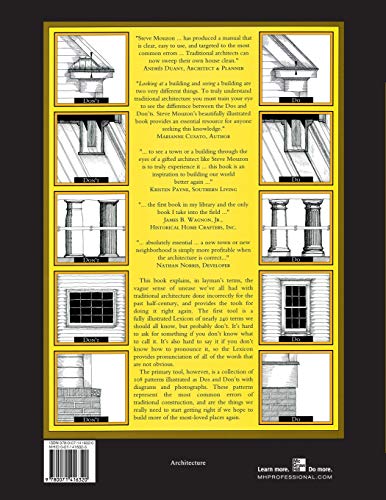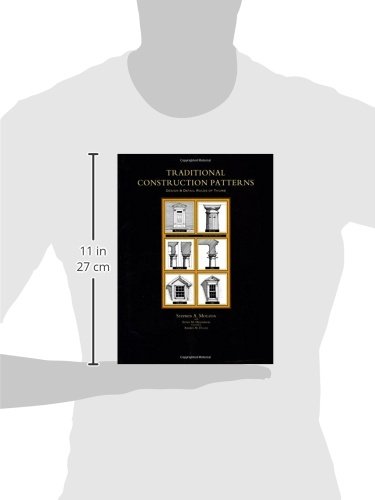



Traditional Construction Patterns: Design and Detail Rules-of-Thumb
A**R
quality of the printing average-poor.
excellent resource for information, but it could have been so much better with really good photos and drawings.
M**A
Mediocre Architecture Explained
Modernism has been the dominant language of architectural schools since the late 1930's. Modernism has never caught on with most of the people who commission architects to design buildigns. They want more traditional buildings that are grounded in America's architectural history. Unfortunately, most architects were not taught to design traditional buildings. As a consequence, America's suburbs are brimming with grotesque Tudors, misshaped bungalows and ackward colonial revival homes.In this volume, Stephen Mouzon assembles a thousand photographs of architectural details. By concentrating on specific building details, he gives examples of designs that are done correctly and others that are completely fouled up. At times, it is humorous and even a bit tragic to see just how illiterate an architect can be.I am not an architect. My hobby is to look at architecture. When I come across real train wrecks, it is easy for me to understand why they do not work. However, I often come across buildings that don't work and I have problems putting my finger on what is wrong. This volume is a field guide to all that can go wrong.Stephen Mouzon's target audience is architects. I would hope that any architect contemplating designing a traditional building will purchase this book. A little bit of study can help spare this country further examples of embarassing architecture. I only wish this book had been written sixty years ago.
T**R
Very Informative but Poor Quality Pages and Cover
I love the information from this book, but the page quality and cover quality is poor. The paper is so thin that one drop of water can ruin tens of pages. For $50 this book is a little pricey, but all in all I would still buy it if I hadn’t already. There is tons of information and lots of techniques.
I**E
fabulous book!
I only wish I had known about this book six months earlier! We're attempting to build a period-inspired colonial house. I was so dissatisfied with the house plans I saw that I decided to just design the house myself using library books and determination. I wanted to build something beautiful and the "anti-McMansion". If only I had had this book earlier we would've done so many things differently: my second floor windows would've been shorter to accommodate all the stuff that's supposed to be under the eaves but now won't fit. I would've put the little stoop in a different spot. My dormers would have different proportions. The only problem with reading this book is that now when I look at our house I see all the things I did wrong.
R**N
stinks, pretty much on all accounts
I've stopped writing reviews on Amazon due to their idiotic review policy, but once in a while an item comes across my desk that pushes it just too far.In this case, it seems like someone needs to put a different spin on this publication.I've given it ONE star because there is some decent (but limited) information however, both authors and publisher should be ashamed of themselves for even trying to charge a penny for it. After a first section of some drawings of traditional architectural elements, the rest or some 75% of it is DONT's and DO's supported by horrible black and white pictures that might do in the 30's, but should be considered trash for ANY publication, including a daily paper.Then the DONT's cover some of the ugliest examples in existence and most certainly not worth devoting that much space to it. They are indeed so ugly, that I can't think of any one in the market for a publication of this kind, who would need to see it.Then you have a chapter 4 on Classical Orders. Makes me wonder what school these authors went to and apparently never heard of a "golden ratio". Not a mention anywhere I can see. At least please, stop calling it a "Classical Orders" chapter, if you don't know the most important find in the name of "classical proportions".Then they have a go at asphalt shingles and clay tile. Here they display a complete ignorance on the subject, stating for example the ONLY asphalt tile of acceptable shape would be of a diamond shape, and in clay tile they apparently been only to Miami. Gee, people take a trip somewhere, you don't know what you've been missing.There is of course NO index. Why bother. In fact an index would feel out of place in here.The bottom line is this: this book has an MSRP of $42, it's soft cover, it's printed on a newspaper level base, it's supported by some of the lowest quality photographs I've seen in ANY book, including those published a century ago. It also falls short in addressing the ACTUAL traditional patterns by devoting an idiotic number of pages to some of the ugliest examples of building structures in existence. If you need this kind of help, you need to change your profession.This book is everything on how NOT to approach a subject, how NOT to design a book, how NOT to publish it, how NOT to whatever. What a waste.And remember, the "Look Inside" feature will not show anything you need to (or should) see to make an educated decision.Those interested in a quality publication on the subject should check out the "Get your house right" by Marianne Cusato. A hard covered book on similar subject but in a superior execution. Better yet, for a LOT less money.--------------------UPDATE of my thoughts: I see that 5 star opinions continue to fly in. I feel so strongly about this one-of-the-worst publications I've seen since the great depression, I have only one thing to add: check it out at a library or a bookstore prior to making the purchase. High reviews in here are as out of place as the attempt to charge for it. As another reviewer stated, there ARE much better choices out there on this subject.
C**L
Useful
While this book is not a textbook on classical architecture, it is the most useful book I've found for "jumping" into the middle of design projects and getting some clarity on why certain designs "make sense" and others are just ignorant ideas. Regular referencing of the book will give any novice a conversant understanding of classical architecture. Most of the book is based in principle, but on ocassion the author slips into personal preference in dogmatic assertions about various designs.
K**I
Excellent Resource
I am using this book to assist in the detailing of my house, which we are renovating right now. I lent it to my architect and he says it is a great resource and time saver. He will be buying himself a copy. This book provides many examples of what to do and what not to do and will allow you to focus in on those details that make homes look "just not right" and correct them before costly mistakes are made.
M**R
Great design resource
We needed a comprehensive design resource when working on historical projects - this book fits the bill perfectly
Trustpilot
3 weeks ago
3 weeks ago